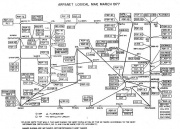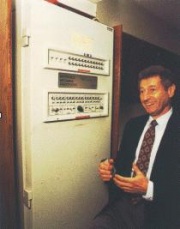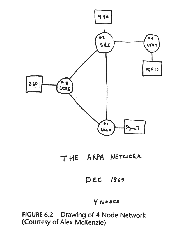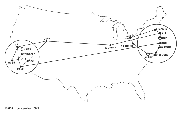ARPANET
From Computing and Software Wiki
| Line 21: | Line 21: | ||
[[Image:kleinrock_imp3.jpg|thumb|right|Leonard Kleinrock with first IMP]] | [[Image:kleinrock_imp3.jpg|thumb|right|Leonard Kleinrock with first IMP]] | ||
By July of 1968 the network was ready to be tested. ARPA was ready to sell it so they asked for bids from 140 different companies. After about a year of negotiating a buyer was found, BBN Technologies (Bolt Beranek and Newman) a high-technology company which provided research and development services. Honeywell's DDP-516 computers were used to connect together and were called Interface Message Processors (IMPs). They were made with special-purpose interfaces and software to test the network and give high speed feedback to the used through a terminal. They were connected to each other using modems connected to leased lines, which are special cable line without a telephone number and each side of the line is permanently connected to the other. Each IMP could have up to four local hosts connected to it and could connect to as much as six different IMPs. | By July of 1968 the network was ready to be tested. ARPA was ready to sell it so they asked for bids from 140 different companies. After about a year of negotiating a buyer was found, BBN Technologies (Bolt Beranek and Newman) a high-technology company which provided research and development services. Honeywell's DDP-516 computers were used to connect together and were called Interface Message Processors (IMPs). They were made with special-purpose interfaces and software to test the network and give high speed feedback to the used through a terminal. They were connected to each other using modems connected to leased lines, which are special cable line without a telephone number and each side of the line is permanently connected to the other. Each IMP could have up to four local hosts connected to it and could connect to as much as six different IMPs. | ||
| + | |||
| + | |||
| + | |||
| + | |||
| + | |||
| + | |||
| + | |||
| + | |||
Revision as of 00:38, 12 April 2008
ARPANET (Advanced Research Projects Agency Network) was the network that became the basis for the Internet. It was developed by ARPA (Advanced Research Projects Agency) of the United States Department of Defense. This network is based on packet switching, as opposed to circuit switching and was the world’s first operational network with that context.
Contents |
Circuit Switching
The old way that networks were run before ARPANET was circuit switching. This is when hosts on a network must establish a fixed connection before they can communicate with each other. That means that specif resources have to be allocated for that connection, so when there is no communication the resources are wasted for no reason, which can get costly. The simple analogy of this network is that of telephone connections. When two people want to talk a special connection is made just for them that will consume resources even if they don't say a word. This worked on a small scale but as one can image it would have been impossible to expand to many networks communicating with such a technology.
Packet Switching
With packet switching came a fresh new look on networks. Hosts on a network can simultaneously communicate with more than one computer by just sending and receiving packets (blocks of data) to each other. So this worked more as a postal system. The guarantee of the message going to the intended receiver is gone, since no concrete connection is established, but on the other side, just like a postal truck many messages can be carried at once which makes things a lot more efficient. So a address is where one would send packets and the network card would act a mailbox. Therefore many packets could be sent out at once and many can be received enabling communication with many hosts at the same time.
Beginnings
J.C.R. Licklider of Bolt, Beranek and Newman (BBN) was the first man to envision the packet switching network. He wrote a series of memos in 1962 the discussed an "intergalactic computer network" with ideas that related almost completely to the Internet that is today. In October 1963 he stareted a program at ARPA dedicated to creating such a network. He soon left ARPA but left his ideas with Ivan Sutherland and Bob Taylor. They continued working on creating a computer communication network. The two major issues in networking computers that they were tackling were:
1. To construct a 'subnetwork' consisting of telephone circuits and switching nodes whose reliability, delay characteristics, capacity, and cost would facilitate resource sharing among computers on the network.
2. To understand, design, and implement the protocols and procedures within the operating systems of each connected computer, in order to allow the use of the new subnetwork by the computers in sharing resources.
The Implementation
By July of 1968 the network was ready to be tested. ARPA was ready to sell it so they asked for bids from 140 different companies. After about a year of negotiating a buyer was found, BBN Technologies (Bolt Beranek and Newman) a high-technology company which provided research and development services. Honeywell's DDP-516 computers were used to connect together and were called Interface Message Processors (IMPs). They were made with special-purpose interfaces and software to test the network and give high speed feedback to the used through a terminal. They were connected to each other using modems connected to leased lines, which are special cable line without a telephone number and each side of the line is permanently connected to the other. Each IMP could have up to four local hosts connected to it and could connect to as much as six different IMPs.
The First ARPANET
Even through ARPA was a military agency the whole project was constructed under the objective of having major universities and research centers communicate between each other electronically, even though later this technology was used by the military to communicate between basses. So naturally the facilities to test out the ARPANET were educational ones. The first ARPANET was four IMPs and were installed at:
- UCLA's Network Measurement Center established by Leonard Kleinrock using a SDS Sigma 7 computer.
- Stanford Research Institute's (SRI) Augmentation Research Center, using a SDS 940 named 'Genie' that ran NLS, a very important early hypertext system created by Douglas Engelbart.
- UC Santa Barbara's Culler-Fried Interactive Mathematics Centre using IBM 360/75 running OS/MVT.
- University of Utah's Graphics Department using DEC PDP-10 running TENEX.
The first message was sent at 10:30PM on October 29, 1969 between the UCLA SDS Sigma 7 Host computer and the SRI SDS 940 Host computer. The first link was made on November 21, 1969, between the IMP at UCLA and the IMP at SRI. On December 5, 1969, the whole 4-node network was connected.
A Suitable Protocol
After the initial setup, representatives from each location got together to start talking about the problem of getting the hosts to communicate via specific protocols. This was needed in order for the machines to be able to communicate with each other in a known language for fast and easy understanding. The initial protocol development lead to DEL (Decode- Encode-Language) and NIL (Network Interchange Language), but these proved to have problems and newer ideas were sought out. The NCP (Network Control Program) was created as what was called the "host to host protocol". The NCP interface allowed application software to connect across the ARPANET implementing higher-level communication protocols. This was an early example of the protocol layering concept. In 1983 the TCP/IP protocols replaced NCP as the main protocol of the ARPANET, and the ARPANET became just one component of the Internet.
Conclusion
The Internet is one of the biggest and most important advancements in the last few decades. The ARPANET was the beginning of such a system. Even thought the vision of the "intergalactic computer network" was forecast no one could have imagined how far it would go.




